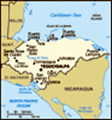Advertisement
Published: November 25th 2008
![Replica of [i]Templo Rosalila[/i] Replica of [i]Templo Rosalila[/i]](//photos.travelblog.net/91870/348234/t/3148791-replica-of-i-templo-rosalila-i-0.jpg)
![Replica of [i]Templo Rosalila[/i] Replica of [i]Templo Rosalila[/i]](/pix/shim.gif) Replica of [i]Templo Rosalila[/i]
Replica of [i]Templo Rosalila[/i]
Full scale size temple inside the courtyard of the Museum of Mayan Sculpture, Copán, HondurasSaturday, November 22, 2008
Today I used my same ticket from the museum of Mayan sculpture from the previous day, to enter the museum again. I told the lady that takes the tickets at the door that the previous day I had not had sufficient time to see all of the sculptures. I actually had the time but my camera had run out of battery power.
The museum is very impressive. Inside a central courtyard are two levels of artefacts, mostly the original pieces from the ruins. Some of the original stelae in the park are left
in situ are protected by little tin roofs and posts. Even the glyphs that are on the ones that have been in the elements for over a thousand years are still readable, well at least to the Mayan epigraphists. Inside this central courtyard is a full scale replica of a Mayan temple discovered within another temple. This temple was named
Templo Rosalila because of the colors of the stuccos that decorate the façade are rose and violet colored. Inside the ruins, you can pay an extra $15 to enter the tunnels within the temples and enter a tunnel that offers a nice

 Macaw stucco
Macaw stucco
Replica of one of the stuccos of a Macaw found on the [i]Templo Rosalila[/i]view of two sides of this
Templo Rosalila. When new kings came into power among the Maya, they would construct new temples on top of the older existing ones. This particular temple was discovered in 1993. The stuccos depict many large Macaw birds in a very mythical form. The Macaw was a bird that apparently held great importance to the Mayan of Copán.
Among the sculptures in this museum, are some of the original stelae from the ruins site as well as some of the best preserved stones that contain faces, hieroglyphics, and figures. Some of the stones are carved with seated Mayan gods or images of the Mayan kings. One of the central gods in the Mayan mythology is the maize god or god of corn. Many of the temples also were adorned with gylphs representing waterlily and corn plants. These two plants represented to the ancient Maya both fertility and life.
Three of my favorite sculptures in the museum are one depicting a scribe, Altar Q, and one of a Mayan king with an elaborate headdress.
The sculpture of the scribe depicts an old man seated with crossed legs with a necklace of some kind.

 Stela
Stela
One of the original stela In his right hand is a stylus or paintbrush. In his left hand is a seashell that has been cut to expose the chambers of the shell. These small chambers would have held inks or pigments of some kind.
Altar Q is a large piece of limestone. The stone is huge. I would say it measures approximately 4 feet by 4 feet, and is approximately 3 feet tall. On each of the four sides of the stone are detailed carvings of 4 Mayan kings. These 16 kings depict 16 dynastic rulers of the city of Copán, from Yax-Kúk´-Mo (Blue-Quetzal-Macaw), the first king of the Mayan city of Copán to Yax-Pac the 16th in the lineage. Alter Q was carved or commissioned in the time of this last great king, Yax- Pac whose accession to the throne is dated 763 A.D. In the carving of Yax-K´uk´-Mo, you can see the quetzal bird or Macaw bird on his headdress and you can see that he is handing the ceremonial sceptre of royal authority to Yax-Pac. Upon the top of this large stone are Mayan glyphs that tell of Yax-K´uk´ -Mo´s arrival to Copan and his succession to the throne by showing

 Stela
Stela
This is the same stela, side view from the upper level of the musem, showing the heiroglyphic textsthis royal sceptre. On one side of the alter you can see the detailed sculpture of the 13th king of this royal line, Waxaklahun-Ubah-Káwil (18 Rabbit). 18 Rabbit is one of the more important kings since many of the carved stelae depict his image and speak of him.
The sculpture of the Mayan king or deity is amazing. The king or god has a headdress of a great waterbird with a fish in its open mouth. On each side of the sculpture are carved waterfalls.
I also walked 2 km from the ruins to another small site that is actually part of the same ancient Mayan city called Las Sepulturas. Here is where many of the people must have lived and they have actually found many tombs.
I got up early on Sunday morning and decided to have breakfast and contract one of the small tour buses for $12. This was a much better idea, since it was a direct bus and only cost about $3 more that the buses on the way there.
Next Stop -- Lake Atitlan
Advertisement
Tot: 0.115s; Tpl: 0.012s; cc: 6; qc: 45; dbt: 0.0777s; 1; m:domysql w:travelblog (10.17.0.13); sld: 1;
; mem: 1.1mb





![Replica of [i]Templo Rosalila[/i] Replica of [i]Templo Rosalila[/i]](http://photos.travelblog.net/91870/348234/t/3148791-replica-of-i-templo-rosalila-i-0.jpg)
![Replica of [i]Templo Rosalila[/i] Replica of [i]Templo Rosalila[/i]](/pix/shim.gif)











